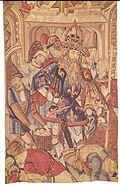History of the English set

Origins and context
Several of the Hampton Court tapestries carry the Brussels town mark and that of one of the most successful Brussels tapestry merchants of the 1530s and 1540s, Willem de Kempeneer. But no documentation relating to its purchase has yet emerged. The works were woven in the workshop of Willem de Pannemaker, one of the leading Brussels weavers. [1] Apart from Bernaert van Orley and Pieter Coecke van Aelst, a number of designers have been suggested in the past, including Giulio Romano and Raphael (the latter wildly improbable as he died in 1520). [3] The tapestries were listed among the king's effects in the 1547 inventory taken following his death. [1] The tapestries are recorded as being hung in the palace during the reign of Elizabeth I. German Paul Hentzner described the series in 1598 as shining with "gold and silver and silk of difference colours" and being "hung up when the Queen gives audience to foreign Ambassadors". [3]
Originally hung in the great hall of Hampton Court Palace and delivered sometime in December 1543 or early 1544, several years after the design process began in 1537. Possibly they were commissioned to celebrate the birth of his only son, later Edward VI of England, by Jane Seymour. [4] [5] Henry's reign was one of political turmoil. He needed a son to bolster his fledgling dynasty and he had recently split with the Roman Catholic Church. He may have used the Old Testament imagery of Abraham's Covenant with God in attempt to legitimise his new position as head of an independent church, and the story of The Circumcision of Isaac to represent his desire for a much awaited male heir. [1]
Later royal use
The tapestries were probably among those described as "scenes from Genesis" used with the Acts of the Apostles to decorate Westminster Abbey for the coronation of Elizabeth I. [6] They were frequently displayed in the following centuries and Charles I hung them at a number of state occasions, including the celebration of St. George's Feast in April 1635, and the receptions of the Moroccan and of the Spanish ambassadors in 1637 and 1649. [1] Following his deposition in 1649, an inventory of Charles I's goods valued the series at "£10 per yard or £8260". However, rather than sell them, as he did with a number of Charles's valuable possessions, Oliver Cromwell decided to retain the series for his own use. [4] In 1656, he ordered the artist Francis Cleyn to make designs for new tapestries based on the set, and one of these suites survives at Blickling Hall. [7]
Following the demise of the Commonwealth of England, the tapestries were once again put to state use. Both Charles II and his successor, James II of England, hung parts of the series at their coronations in Westminster Abbey. [8] It was at this time that Charles II commissioned a second set of lesser quality, replicating the Story of Abraham series, which still hang in Jerusalem Chamber of Westminster Abbey; the reason for this commission remains unknown. Repairs were carried out on the originals in 1663 and 1664. [3] During the reign of William III, some of the series was hung in the King's Bedchamber. By 1742 they were recorded as being set in the Audience Chamber and Drawing Room at Hampton Court. [1]
Whilst some of the tapestries were used at the coronations of George I and George II, the tapestries 'languished' during the Hanoverian era. They were still in a good state of repair by 1727, being described as "very large and very rich with silver and gold", but by this point Hampton Court had ceased to be a regular residence for the monarch a great number of the palaces treasures were transported elsewhere to furnish other palaces. With little interest from succeeding monarchs, the palace was converted into a museum by William IV in 1830. [3]
Victorians to the present day
By the coronation of Queen Victoria, Hampton Court had suffered massive deterioration. Both the queen and Prince Albert took an interest in improving standards at the palace and a new scientific approach to conservation was emerging. Five of the tapestries were rehung in the great hall in 1841, with a further two being rehung at the Chapel Royal, St James's Palace. [2] By 1884 the condition of a number of tapestries at Hampton Court, including the Story of Abraham series, had reached parliament and the Treasury granted a sum of £400 for 13 needle-women to complete restoration on some 37 works. In 1887 they were valued at £200,000. George V set up a committee tasked with preserving the tapestries in 1912. The committee was established at Hampton Court, judging the tapestries too fragile and valuable to be moved. Restoration continued through the First World War, with each tapestry taking an estimated five years to complete. By 1961, The Meeting of Abraham and Malchizedek remained the only unrestored tapestry. [3]



